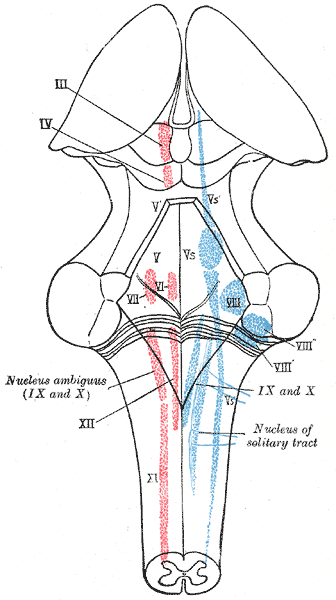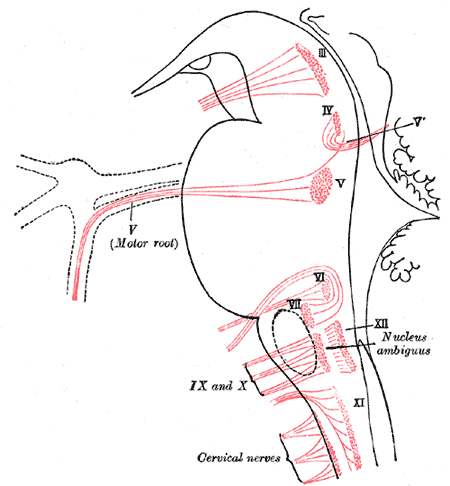Facial motor nucleus
The facial motor nucleus is a collection of neurons in the brainstem that belong to the facial nerve (cranial nerve VII). These lower motor neurons innervate the muscles of facial expression and the stapedius.
Anatomy
The nucleus is situated in the caudal portion of the ventrolateral pontine tegmentum. Its axons take an unusual course, traveling dorsally and looping around the abducens nucleus, then traveling ventrally to exit the ventral pons medial to the spinal trigeminal nucleus. These axons form the motor component of the facial nerve, with parasympathetic and sensory components forming the nervus intermedius.
The nucleus has a dorsal and ventral region, with neurons in the dorsal region innervating muscles of the upper face and neurons in the ventral region innervating muscles of the lower face.
Classification
Because it innervates muscles derived from pharyngeal arches, the facial motor nucleus is considered part of the special visceral efferent (SVE) cell column, which also includes the trigeminal motor nucleus, nucleus ambiguus, and (arguably) the spinal accessory nucleus.
Cortical input
Like all lower motor neurons, cells of the facial motor nucleus receive cortical input from the primary motor cortex in the frontal lobe of the brain. Upper motor neurons of the cortex send axons that descend through the internal capsule and synapse on neurons in the facial motor nucleus. This pathway from the cortex to the brainstem is called the corticobulbar tract.
Interestingly, the neurons in the dorsal aspect of the facial motor nucleus receive inputs from both sides of the cortex, while those in the ventral aspect mainly receive contralateral inputs (i.e. from the opposite side of the cortex). The result is that both sides of the brain control the muscles of the upper face, while the right side of the brain controls the lower left side of the face, and the left side of the brain controls the lower right side of the face.
Effects of lesions
As a result of the corticobulbar input to the facial motor nucleus, an upper motor neuron lesion to fibers innervating the facial motor nucleus results in central seven. The syndrome is characterized by flaccid paralysis of the contralateral lower face. For example, a left corticobulbar lesion results in paralysis of the muscles that control the lower right quadrant of the face.
By contrast, a lower motor neuron lesion to the facial motor nucleus results in paralysis of facial muscles on the same side of the injury. This condition is known as Bell's palsy.
Additional images
-
The cranial nerve nuclei schematically represented; dorsal view. Motor nuclei in red; sensory in blue.
-
Nuclei of origin of cranial motor nerves schematically represented; lateral view.
-
Primary terminal nuclei of the afferent (sensory) cranial nerves schematically represented; lateral view.


